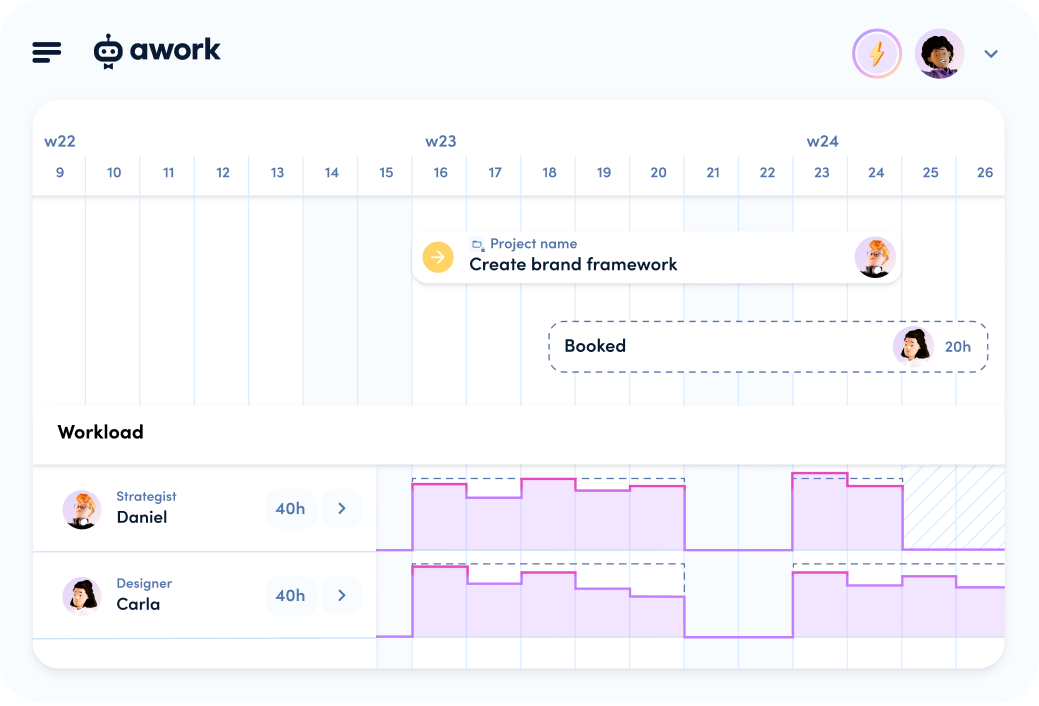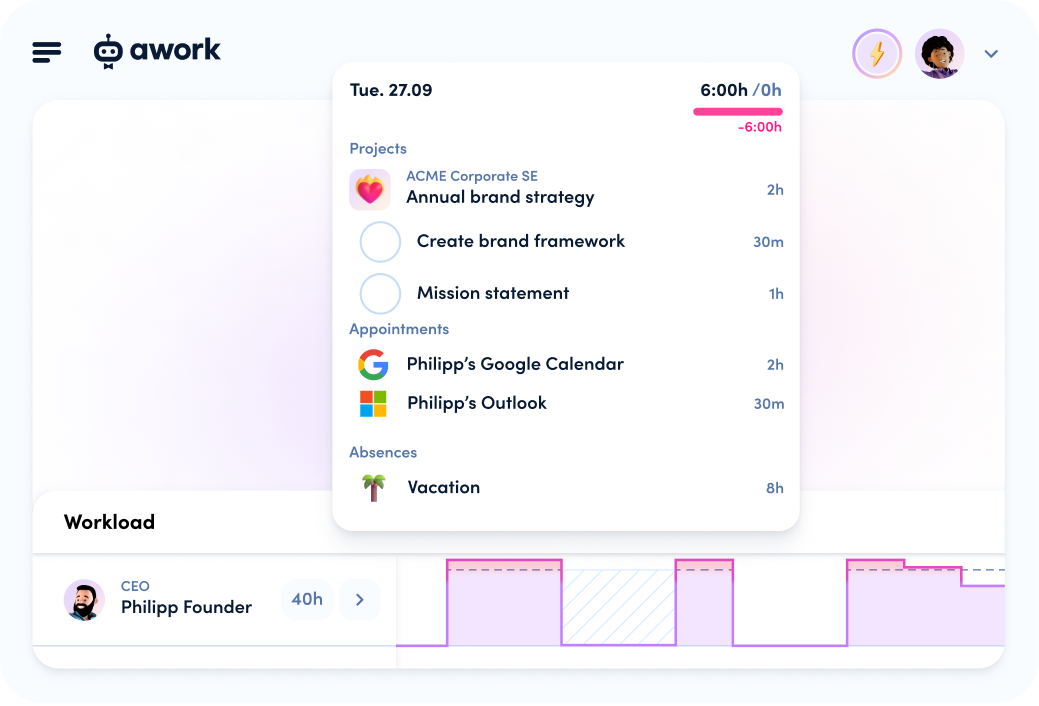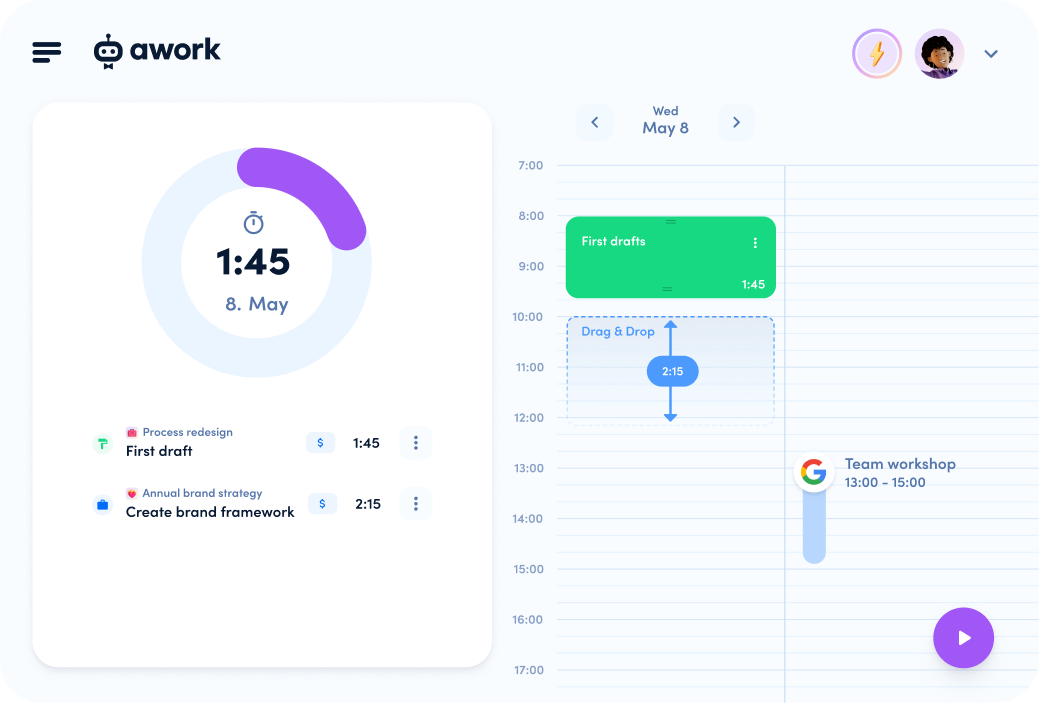Sorry, I just have to quickly…
… send the newsletter.
… answer a Slack message.
… give feedback to a colleague.
… handle a call with the customer.
… create the Excel spreadsheet.
Sound familiar? In today's working world, we quickly get the feeling of permanent work stress because we are working on so many topics at the same time and want to get them done "just quickly". At the end of the day, we have the impression that we haven't accomplished anything of what we actually set out to do - as a result, we feel stressed, unproductive, and not at all happy. Science is also concerned with this rush-hour life: According to a 2019 study by YouGov, 82 percent of all respondents felt stressed at work - that's four out of five workers. Even more so, In the last two "pandemic years," the work stress phenomenon is likely to have intensified.
What can we do to bring more joy back into our working lives? How do we escape the work stress trap? We spoke to expert Johanna Heußner from CoachYourVenture about this. We wanted to know why we sometimes find it so difficult to set clear boundaries at work and how constant work stress worsens our long-term performance.
Johanna gives you hands-on tips and honest advice about work stress in this post. As a profiler and business psychologist, she focuses intensively on current personality, behavioral, and communication psychology topics and brings years of practical experience from systemic coaching.
Spoiler Alert: In the second part of this post, we'll tell you why an intuitive project management tool like awork can reduce your work stress and bring you more joy in your daily work.
Always on – What does it mean for our health?
Hey Johanna! It's become almost normal to spend the end of the day working. Some even work late into the night simply to escape the constant time and performance pressure. Overall, it seems as if work and private life are becoming increasingly blurred. What are the health and mental risks of this "always-on mentality" for us as employees?
In the case of short-term stress, hormones are released that are actually helpful for the moment. They make us more efficient, reduce sensitivity to pain and strengthen the immune system. With longer-lasting stress, the dose turns into poison, and the effects are reversed by constant "alertness". Our performance is significantly reduced, short-term memory and concentration suffer. In addition, sleep quality is reduced, and we are significantly more susceptible to illness. Instead of increasing performance, the "always-on mentality" reduces our performance.
According to the work-life balance model, work and private life should be in harmony with each other. What should the optimal balance between work and leisure look like?
How much work stress you can tolerate and when the positive effects turn into the opposite varies from person to person. Sometimes private life is more stressful than a fulfilling job. After stressful phases - whether private or professional - it is generally important to recharge the batteries properly, with whatever gives you strength - sports, reading in peace, meditating, meeting friends. The prerequisite for this is, of course, that you 1) notice how you feel and what brings you happiness and 2) then also take the time for it.
And how do I find out whether I have the right work-life balance?
Optimally, you have good access to yourself and an intuitive sense of whether tension and relaxation are in a good balance. But not everyone succeeds in doing this. A bad balance is often only noticed later through stress symptoms: One is irritated, quickly annoyed, and tired. If the "alertness" has taken on a life of its own due to constant high stress, the feeling of inner restlessness persists, even though there is no rational reason for it. Since one quickly gets used to the symptoms, one can also keep a kind of work stress diary to assess the well-being more objectively. Or you can ask people who know you well about their impressions.
We often hear tips such as taking time off, asking the boss to work fewer hours, and delegating tasks to reduce work stress - but in the end, implementing them is not so easy. Why do so many people find it so difficult to set clear boundaries and consciously break away from performance thinking?
Whenever we want to achieve a goal (go towards), there is always the opposite that we want to avoid (stay away from). And it is precisely the "away-from" that makes life difficult for us. The negatively anticipated consequences drive us: for example, the fear of being perceived as lazy or conflict-averse or of making mistakes. Also, the threat of losing control, power, and influence pushes us "away from" and "toward" more work.
Such fears are unfounded most of the time. But the often unconscious emotional cost-benefit calculation weights possible negative consequences more heavily than real health risks. This can affect all levels of the hierarchy. If you, yourself, would like to reduce your performance with a clear conscience, the alarm bells can still ring with your supervisor. Team members can quickly tell from body language or half-hearted slogans whether rest is actually okay or whether work-life balance is just a fine-sounding phrase in the company's principles.
It is not only the employee who bears responsibility, but also the boss. What can employers and team leaders do to protect their team from burnout and work stress, especially in the home office? Do you have some hands-on tips for us?
From my point of view, it is important to be fully mentally behind the measures and to be honest with yourself. Are there any negatively anticipated consequences, if any? What negative experiences have you had before, and what impact do those thoughts and experiences have on the goal of protecting the team from burnout in the home office?
I am also a big fan of finding individual solutions together with the team, e.g., preventing misuse of freedoms. If you take time for the topic in a small workshop, you can come up with amazingly ingenious and versatile solutions that fit the team and the situation perfectly. There is also nothing to be said against openly sharing one's concerns with one's team in order to make one's behavior more understandable.
Is there any other tip, experience, or impulse on the topic of work stress that you would like to share with us?
Supportively, it can help to set s.m.a.r.t. goals not only for performance but also for rest. For example, when, how often, and how long do you want to take a break during a workday? How much time do you want to invest in relaxing hobbies and what is important to you? With conscious goals, you can better prioritize and track whether you've allowed yourself time for rest. Also, the question "What's the worst that can happen?" reflects that the negative consequences are usually not as bad as the inner critic makes it seem.
Can a project management tool reduce your work stress and bring more joy to your to-dos?
Mindset, one's own approach to oneself, and the general handling of stress at work (also from an employer's perspective) are essential factors for a healthy work atmosphere. We are convinced that good time and project management and modern tools can help reduce work stress. Together with you, we will go through three everyday scenarios and show you how you can master these challenges easily with awork.
The Pain: Constant overload and lack of capacity produce work stress.
"Do you still have capacity?" - the standard saying in your team. Planning is done with Excel lists, sticky notes, or chalkboards (😜). If a colleague is absent, the to-dos are randomly handed over to other team members - sometimes without their knowledge and at the whim of the team leads. Overlaps with other projects are constant - but no one really knows when exactly.
The result:
- Deadlines are missed.
- The team is permanently stressed.
- Lastly, important milestones are not reached because everything gets lost in the to-do chaos.
The solution: Make capacities visible and avoid bottlenecks
In this case, it is not surprising that your team feels overloaded and that there are no open capacities due to a lack of organization. This is because the existing methods do not give you the proper overview between projects, nor can you react flexibly to bottlenecks and reschedule tasks. In addition, you reach your limits far too quickly with Excel, sticky notes & Co. when coordinating distributed teams and are trapped in constant work stress.

With the team planning in awork, you can switch between the project and team view. In the project view, you can show all projects that are relevant to you. This way, you can see at first glance if projects, milestones, or important deadlines overlap. If you see overlaps, you can expand the project and see all team members and their tasks. You can also make sure that to-dos are evenly distributed in parallel projects.
In the team view, the focus is on the personnel workload. In contrast to the project view, you can show team members and their capacities instead of projects.
In addition, a solution must be found if a team member is on vacation or absent due to illness. Because in this case, for time reasons alone, not every job can simply be handed over. After all, no one can manage the jobs of two people at the same time. With the classic handover email (or a handover meeting), the worst can be clarified. There you ask yourself which tasks have to be done and what can be left undone. The transfer of fixed deadlines and responsibilities provides security and enables transparent workflows. Pro-Tip: If you want to learn more about team planning in awork, you will find all important info here!
The Pain: Bad time management and overtime like sand on the beach
You have to postpone the deadline for the fifth time, can't save yourself from overtime, and don't know where your head is anymore because of all the to-dos? If you don't have good time management, you are often under a lot of stress. The lack of prioritization of tasks makes it difficult to concentrate on the important things. Maybe you spend too much time on administrative issues instead of focusing on implementing a strategy. But how do you know what you're spending your time on and how to be more productive?
The solution: Intuitive time tracking for productive work without the constant work stress
Both in our jobs and in our private lives, we often tend to do things "quickly". But it happens all too often that the feedback of a newsletter takes 30 to 60 minutes or the call with a customer takes longer than expected. Nothing with "just quickly" is actually quick. That's why it's so important to get a realistic picture of your workload. The easiest way to do this is with time tracking.
In awork, you can easily record times for a specific task or project: via the global timer, drag-and-drop in the weekly view, or directly in a task, also via the timer. Afterward, you can evaluate these times, export them or forward them directly to an invoicing tool of your choice.

Preferably start in the first week with being extremely consistent with time tracking on everything you do. Record all tasks, even the things you do quickly on the side, for this week. This will give you a detailed insight into the areas in which you use your time. In addition to a much better feeling for the actual effort required, you will also recognize the costs of the individual activities. In most cases, you will be surprised how much your own estimation differs from reality. Use your findings to set priorities more consistently in the future and to plan efforts more realistically.
If you have trouble prioritizing and intuitively determining which to-do is most important, you can work with the Eisenhower-Matrix. This will effectively help you reduce your work stress through sensible task planning. You go through all your collected to-dos and divide them into four quadrants. You distinguish between to-dos that are important and urgent (priority 1), tasks that are only important or urgent (priority 2), and those that have neither importance nor urgency.
This will give you a much better overview of how many tasks need, how much attention from you, and which tasks can still wait. So that you can take care of these particularly relevant tasks first, you should delegate other tasks to your team. Some Prio 3 topics can probably be eliminated completely.
The Pain: Incorrect communication hinders your cooperation and causes work stress
Do missing agreements, inaccurate briefings, and a lack of overview make your life difficult? That is pure work stress. It's not just team productivity that suffers from miscommunication, but also your team cohesion. How can this be improved?
The solution: Successful collaboration thanks to clear communication
Successful collaboration requires meaningful communication and a high level of transparency - regardless of whether your team works in the office or remotely. awork supports you in this! communicate with your team members directly in tasks, assign them to-dos and keep an eye on capacities. This way, you can not only communicate precise work instructions, but everyone in the team keeps a constant overview of the status of all tasks and all agreements. These measures reduce work stress enormously.























